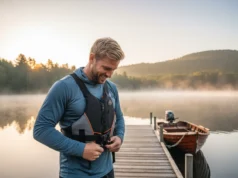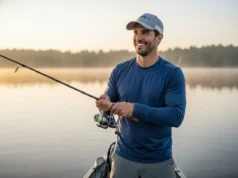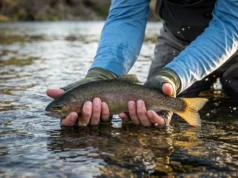In this article
You stand in the aisle of the sporting goods store, staring at a wall of rods that stretches for forty feet. The marketing tags scream “High Modulus,” “IM7,” and “Zero-Reverse,” but none of them tell you if the rod will snap the first time you hook a tree branch.
For the beginner, the barrier to entry isn’t the cost; it is the “Analysis Paralysis” induced by infinite choice and opaque engineering. You don’t need a tournament-grade arsenal. You need a tool that balances the physics of forgiveness with the mechanics of success.
In this guide, we walk through the physics of failure—why graphite is sensitive but brittle—and why fiberglass is the beginner’s safety net. We will decode the Action/Power Matrix, distinguishing “Backbone” from “Flex,” and provide persona-based loadouts for everyone from the Nervous Novice to the Little Angler. Finally, we cover the biological ethics essential for catch-and-release success.
How to Choose the Right Fishing Gear Setup
Why Does Rod Material (Graphite vs. Fiberglass) Matter?
Rod material dictates the critical trade-off between durability and sensitivity. Fiberglass is heavy and “parabolic,” meaning it bends deeply into the handle. This makes it nearly indestructible and incredibly forgiving of mistakes, acting as a shock absorber for clumsy hooksets.
Graphite, or carbon fiber, sits on the opposite end. High modulus graphite offers incredible weight reduction and vibration transmission, allowing you to feel a fish breathe on your bait. However, it is brittle and tolerates zero impact abuse.
For most beginners, the smart money is on a composite solution. This is the “Goldilocks” zone that fuses a graphite core with a fiberglass tip to prevent the most common beginner failure: tip breakage. While the U.S. Fish & Wildlife Service guide to fishing offers a broad overview of getting started, the nuance lies in selecting spinning rods as skill-building tools that prioritize survival over sensitivity.
Why Are “Power” and “Action” Often Confused?
Power is the resistance required to bend the rod, while Action defines exactly where that bend occurs along the blank. To pick the right engine for your fishing, you must distinguish between these two critical mechanics.
For general purposes like Bass or Walleye, “Medium” is the universal standard for Power. Action, conversely, is about flex. “Fast” action bends strictly at the tip for precision, while “Moderate” action bends in the middle for shock absorption.
For a beginner, the sweet spot is a Medium Power rod with Moderate-Fast Action. This provides enough backbone to drive a hook home but enough flex to keep a fish pinned during a chaotic fight. The Kentucky Department of Fish & Wildlife breaks down the physics of Power vs Action well. However, for a deep dive into matching these specs to specific lures, our guide on decoding rod power and rod action is essential reading.
Why Line Choice is the “Shock Absorber” of the System?
Line choice acts as the shock absorber of the entire system because Monofilament (nylon) stretches up to 25% under load. This elasticity is vital for beginners, buffering the shock if you set the hook too hard or fight a fish with the drag locked down.
Beyond stretch, monofilament bites into itself, offering superior knot security compared to slippery braided lines. While veteran anglers love braid for its sensitivity, it is a “Phase 2” upgrade. Braid is prone to “wind knots” and offers zero shock absorption, which often leads to pulled hooks for novices. You can see the knot strength physics detailed by Salt Strong, or review our data-driven showdown of braid vs fluorocarbon vs monofilament to see exactly why mono remains the king of the learning curve.
Pro-Tip: When spooling monofilament, soak the spool in warm water for 10 minutes before winding it onto your reel. This relaxes the nylon memory and drastically reduces tangles on your first trip.
Our Selection Process: How We Built This Guide
We commit to absolute objectivity, ignoring “box store” marketing claims to focus on the engineering specs that determine longevity. Every rod and reel in this guide was scored on a weighted matrix of Durability (resistance to impact/abuse), Sensitivity (vibration transmission), and Ease of Use (forgiveness of error).
We analyzed distinct personas—from the “Greenhorn” who fears breaking gear to the “Aspiring Pro” seeking finesse—and matched them with the specific engineering solution that solves their primary pain point. While we may earn a commission through affiliate links, our recommendations are driven by the graduation path from novice to expert. We ensure you buy the right tool for your current skill level.
The Best Fishing Gear of 2026: Our Top Recommendations for Every Need
Our Top Picks for The “Greenhorn” & “Value Hunter” (General Beginner)
Our Top Picks for The “Aspiring Pro” & Saltwater Angler
Our Top Picks for The “Little Angler” (Youth/Kids)
The Final Cast
We’ve stripped away the marketing jargon to focus on what keeps you fishing: durability and forgiveness. Start with Monofilament line; its stretch is your safety net against mistakes. Prioritize Durability (Fiberglass/Composite) over Sensitivity (Graphite) for your first rod.
Remember that Licensing is conservation: 100% of your fee funds the stocking and protection of the fish you catch. Finally, always wet your hands before handling a fish to protect its slime coat and ensure survival.
Don’t overthink the purchase. Grab the Ugly Stik or the Sienna, buy a license, and get your line in the water—because the only gear that catches zero fish is the gear that stays in the shopping cart.
FAQ – Frequently Asked Questions
Do I really need a fishing license if I’m just catching and releasing?
Yes, a license is legally required for the act of fishing, regardless of whether you keep the fish. Fees directly support conservation. See our guide to understanding fishing licenses and conservation for more details on fees and rules.
What is the strongest knot for a beginner to learn first?
The Uni Knot is the most versatile option, capable of tying line to the spool, hooks, and joining two lines together. For connecting hooks to Monofilament, the Improved Clinch Knot is a reliable standard.
Why do my fish die even when I let them go?
You may be removing their protective slime coat with dry hands or towels, leading to fatal infections. Always wet your hands and review mastering science-backed catch and release techniques to improve survival rates.
Can I use a freshwater reel in the ocean?
Technically yes, but the salt will corrode the internal magnesium and aluminum components within weeks. We recommend understanding the critical differences between saltwater and freshwater gear durability before making a crossover mistake.
Risk Disclaimer: Fishing, boating, and all related outdoor activities involve inherent risks that can lead to injury. The information provided on Master Fishing Mag is for educational and informational purposes only. While we strive for accuracy, the information, techniques, and advice on gear and safety are not a substitute for your own best judgment, local knowledge, and adherence to official regulations. Fishing regulations, including seasons, size limits, and species restrictions, change frequently and vary by location. Always consult the latest official regulations from your local fish and wildlife agency before heading out. Proper handling of hooks, knives, and other sharp equipment is essential for safety. Furthermore, be aware of local fish consumption advisories. By using this website, you agree that you are solely responsible for your own safety and for complying with all applicable laws. Any reliance you place on our content is strictly at your own risk. Master Fishing Mag and its authors will not be held liable for any injury, damage, or loss sustained in connection with the use of the information herein.
Affiliate Disclosure: We are a participant in the Amazon Services LLC Associates Program, an affiliate advertising program designed to provide a means for us to earn advertising fees by advertising and linking to Amazon.com. As an Amazon Associate, we earn from qualifying purchases. We also participate in other affiliate programs and may receive a commission on products purchased through our links, at no extra cost to you. Additional terms are found in the terms of service.





